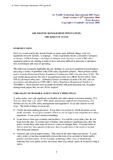- CERES Home
- →
- School of Engineering (SoE)
- →
- Staff publications (SoE)
- →
- View Item
JavaScript is disabled for your browser. Some features of this site may not work without it.
| dc.contributor.author | Brooker, Peter | |
| dc.date.accessioned | 2007-03-23T19:52:06Z | |
| dc.date.available | 2007-03-23T19:52:06Z | |
| dc.date.issued | 2007 | |
| dc.identifier.citation | Brooker P. (2007) Air traffic management innovation: the risks of STASIS. Air Traffic Technology International, 2007, pp. 86-90 | en |
| dc.identifier.uri | http://hdl.handle.net/1826/1502 | |
| dc.identifier.uri | http://www.ukintpress.com/mag_airtraffic.htm | |
| dc.description.abstract | Stasis is a word used by the ancient Greeks to mean many different things: civil war, arguments between factions, ‘a stoppage’. Today it generally means a cessation of progress or change. ATM in Europe is in danger of being in stasis, because current ATM safety regulation policies are tending to make it more and more difficult to innovate, to introduce new technologies and ways of operating. The following essentially highlights the key findings of a group of published research papers analysing a variety of problems with ATM safety regulation policies. These policies mainly derive from the Eurocontrol Safety Regulation Commission (SRC), but also from ICAO. The case studies discussed are: the role of ground-based safety nets (Short Term Conflict Alert – STCA); air-based safety nets – Airborne Collision Avoidance Systems (ACAS); and risk assessment and mitigation in ATM (SRC’s Safety Regulatory Requirement Number 4 – ‘ESARR4’). These policies were no doubt developed with good intentions but, in quality management jargon, they are not ‘fit for purpose’. | en |
| dc.format.extent | 53287 bytes | |
| dc.format.mimetype | application/pdf | |
| dc.language.iso | en | en |
| dc.publisher | UK international Press Media & Events | en |
| dc.title | Air traffic management innovation: the risks of STASIS | en |
| dc.type | Article | en |
Files in this item
This item appears in the following Collection(s)
-
Staff publications (SoE) [603]
